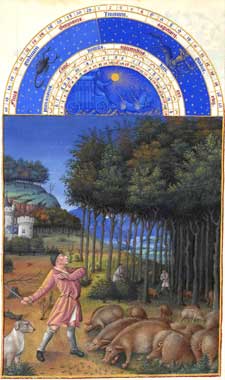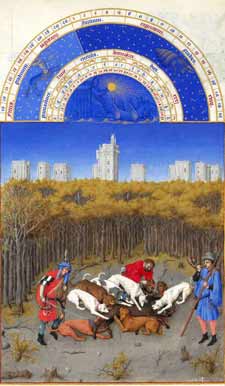various French and Dutch Artists, (1410-1489)

-
November – peasants feeding the hogs
- [Les très riches heures du Duc de Berry: Ms 65; Folio 11v]
- (1412 – 16), illumination on vellum
- 8.9 x 5.4 in.(22.5 x 13.6 cm.)
- Musée Condé, Chantilly
-
Editor’s Note:
Unlike most of the landscapes in this work, the scene for November does not depict a specific place related in some way to the Duc de Berry. The picture shows the autumn acorn harvest, with a peasant knocking down throwing sticks to knock down the acorns on which pigs are feeding.
This is the only calendar image executed by Jean Colombe; the Limbourgs painted only the zodiacal tympanum above it.

-
December – wild boar hunt in the forests near Château de Vincennes
- [Les très riches heures du Duc de Berry: MS 65; Folio 12v]
- (1412 – 16), illumination on vellum
- 8.9 x 5.4 in.(22.5 x 13.6 cm.)
- Musée Condé, Chantilly
-
Editor’s Note:
Here the scene is in the forest of Vincennes, long fabled for its game. In the background is the Chateau de Vincennes, a residence of Duc de Berry and other French royalty. A wild-boar hunting group has caught a boar and it is being attacked by boarhounds.
Barthélemy van Eyck, thought to be the Master of the Shadows, painted this scene.
About the Artist
Les Très Riches Heures du Duc de Berry [The Very Rich Hours of the Duke of Berry ] is an illuminated manuscript and book of hours. It is now held in France and considered to be of immense historical and cultural importance, equal to works such as the Mona Lisa, and marking the pinnacle of the art of manuscript illumination.
The Limbourg brothers began this book of hours for Jean de Berry, brother of King Charles V of France in about 1410. But early in 1416, Jean de Berry and the three brothers Limbourg (all three less than 30 years old) died of unknown causes, and the Très Riches Heures remained un bound and unfinished.
The book was worked on, over a period of nearly a century, in three main documented campaigns, led first by the Limbourg brothers, then by Barthélemy van Eyck and finished by Jean Colombe.
Limbourg brothers, Herman, Paul and Johan, (b. ca 1385/88 – d. 1416), Dutch. The Limbourgs were Dutch Renaissance miniature painters. They were among the first to render specific landscape scenes with accuracy. Their work was a major influence on the course of the 15th century art of manuscript illumination.
The Dutch painter and manuscript illuminator Barthélemy van Eyck, (c. 1420 – cc. 470), is thought to be the Master of the Shadows, responsible for parts of the calendars of the Très Riches Heures, particularly the scenes for March, October and December.
Jean Colombe (cac. 30-1435 – 1493) was French. He was commissioned by Duc Charles I de Savoie to do the final work on Très Riches Heures. The calendars themselves were mostly painted by the Limbourgs, but November includes a substantial amount of Colombe’s work. Très Riches Heures was completed between 1485 and 1489.
